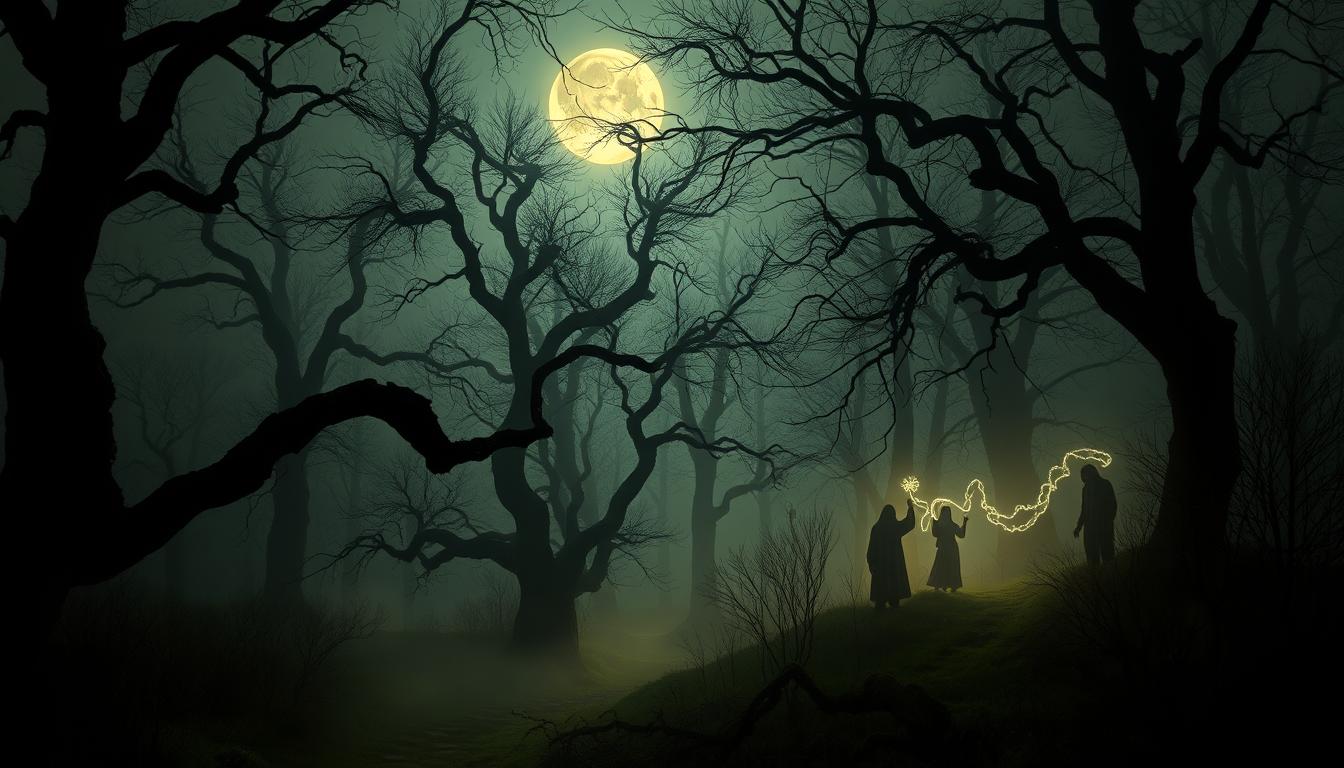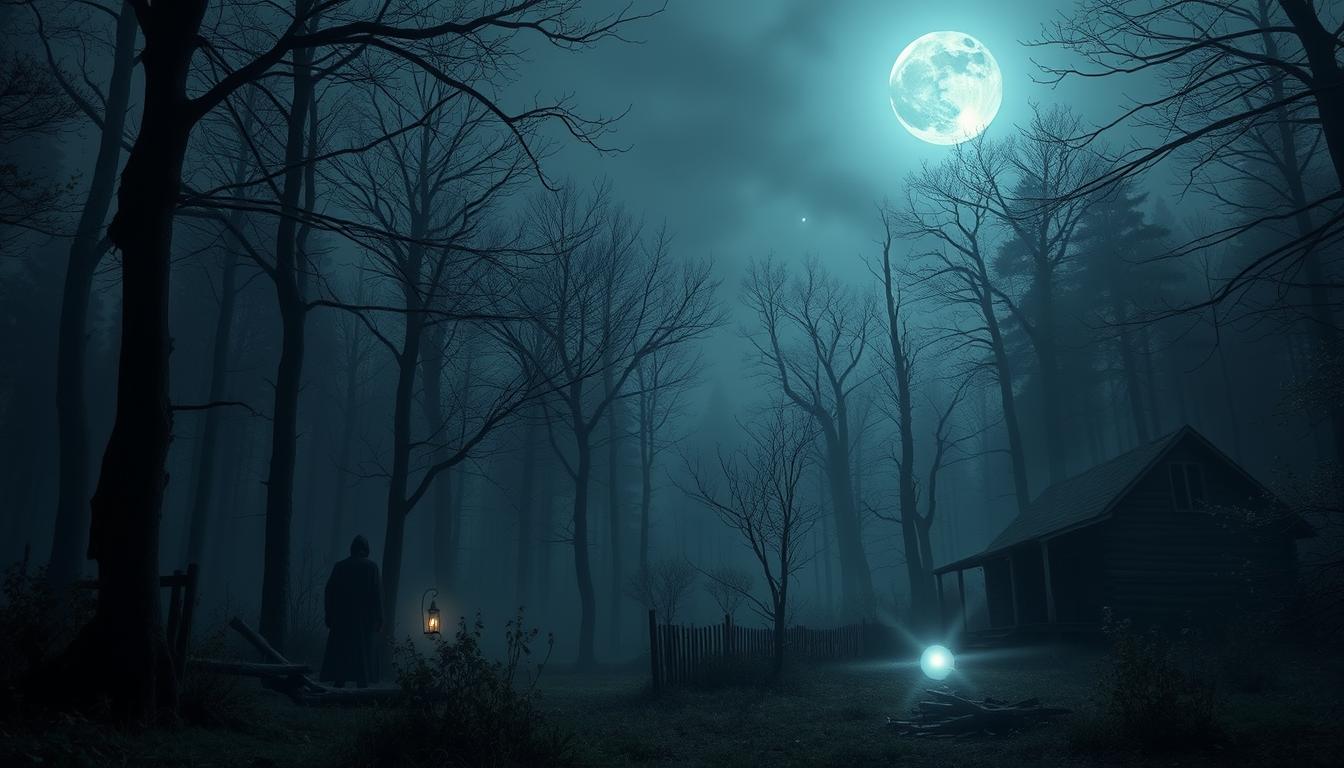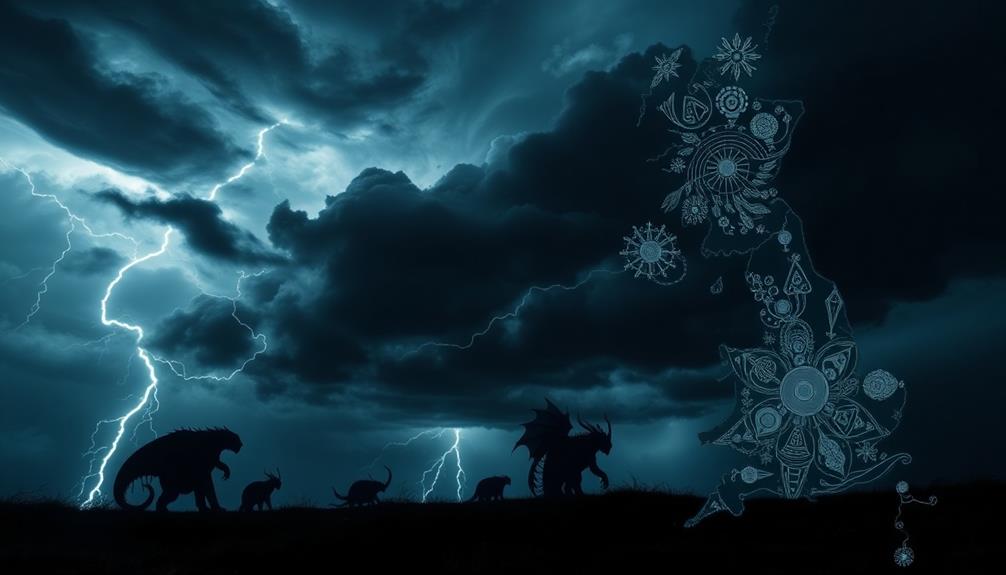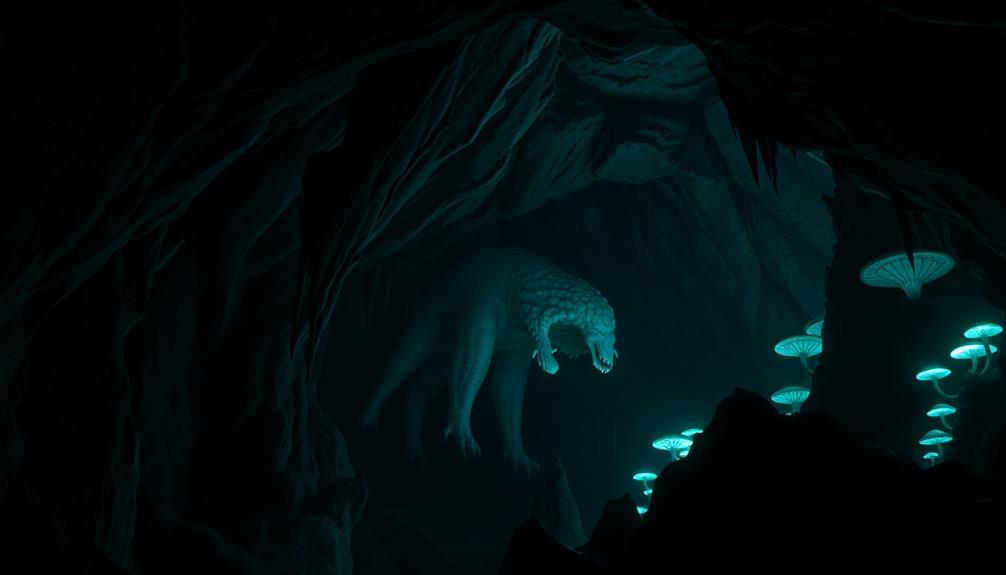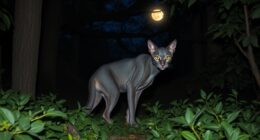Have you ever felt that shiver run down your spine when you hear a strange sound in the night? That electric thrill of fear and fascination is something many of us experience, especially when delving into the world of haunted folklore. We are naturally drawn to supernatural stories that blur the lines between reality and myth, revealing our collective longing to understand the unknown.
Across the United States, ghost legends and paranormal myths offer a captivating glimpse into diverse cultures and histories. From the Hawaiian Night Marchers, thought to be the spirits of ancient warriors roaming sacred paths, to tales of Bigfoot echoing through the hills of the Appalachian Mountains, these narratives weave through our past and present, creating a rich tapestry of belief. Each haunted location that you explore tells a story – a moment frozen in time where the uncanny meets history, whispering secrets only a few dare to hear.
The deeper you dive into these eerie tales, the more you may find pieces of yourself reflected in the fears and hopes of those who came before. As we embark on this journey through the diverse landscapes of American haunted folklore, prepare to encounter tales that resonate not just with fear but also with the curiosity that binds us all.
Key Takeaways
- Haunted folklore is a blend of Indigenous, Christian, African, Irish, and Scottish traditions.
- Notable historical figures are often linked to ghost sightings across the country.
- Many haunted locations are significant sites of historical events.
- Common paranormal occurrences range from poltergeists to sightings of spectral armies.
- Cities like New York are rich in ghost stories and reported paranormal activities.
- Legends like La Chupacabra have origins that span across various cultures in America.
The Allure of Haunted Folklore
The fascination with the allure of haunted folklore has captivated countless individuals across generations. Ghost stories, combined with urban legends, serve as a mirror reflecting our deepest fears and curiosities. These tales often blur the lines between reality and imagination, drawing you into myths that resonate with personal and communal experiences.
Locations steeped in mystery, such as the Eastern State Penitentiary in Philadelphia and the notorious Aokigahara Forest in Japan, provide tangible connections to the supernatural. The transformation of such sites into haunted attractions heightens their allure, encouraging visitors to confront their fears in a playful manner. Institutions like the Pennhurst Asylum also captivate audiences with their dark histories and alleged hauntings, enhancing interest in ghost stories that span both time and culture.
Haunted houses often emerge as seasonal sensations, particularly during Halloween. These attractions evoke nostalgia, allowing adults to relive cherished memories of ghost stories and trick-or-treating. Attractions like the Folklore Haunted House in Atlanta captivate guests with immersive experiences, boasting awards and impressive customer reviews. Each journey through these haunted spaces unearths layers of local lore, while nightly encounters with changing monsters add a unique twist to the experience.

In this way, urban legends and ghost stories not only thrill but also serve as cultural touchstones, weaving the collective identity that binds communities. The allure of haunted folklore continues to thrive, fueling curiosity and sparking conversations about the unknown.
Supernatural Stories from the Appalachian Mountains
The Appalachian Mountains, among the oldest mountains on Earth, cradle a multitude of captivating ghost stories and rich folklore. This region, steeped in history and tradition, has a remarkable legacy of supernatural narratives shaped by a tapestry of cultural influences. Elements of Irish, Scottish, Indigenous, and African traditions blend seamlessly within these tales, providing them with unique character and depth. As settlers arrived, they brought with them beliefs that mingled with existing myths, creating a distinctive atmosphere of haunted lore that continues to intrigue today.
Appalachian Lore and Its Origins
Appalachian folklore has deep roots in the personal experiences and everyday hardships faced by people in the region. The tales often reflect significant local events or tragedies, intertwining personal narratives with broader themes of love, loss, and revenge. From these narratives emerge notable ghost legends like the Bell Witch, a haunting that captured the attention of many in the early 1800s in Tennessee. This eerie tale reflects collective memories and the power of storytelling, serving as a cultural touchstone for many communities within the Appalachian mountains.
Notable Ghost Legends in the Region
Among numerous Appalachian ghost stories, some stand out due to their profound impact on local lore. The Bell Witch haunting, known for its unexplainable occurrences, left an indelible mark on the area. Similarly, the Mothman, spotted over 55 times in 2017 in the Point Pleasant area, adds to the region’s legendary status. The Flatwoods Monster urban legend, originating in 1952, showcases a tall, man-like figure with a red face, sparking curiosity and spurring further supernatural storytelling.
The enigmatic Brown Mountain Lights, a mysterious phenomenon in Burke County, North Carolina, has fascinated residents for centuries. This region’s ghost stories frequently emanate from firsthand encounters, ensuring their transmission through generations. From the charming stories of Bristol’s first ghost, a Native American spirit, to multiple Bigfoot sightings occurring in the Appalachian woods, the supernatural remains an integral part of Appalachian life.

| Ghost Legend | Location | Key Details |
|---|---|---|
| Bell Witch | Tennessee | Documented haunting in the early 1800s. |
| Mothman | Point Pleasant | Over 55 sightings reported in 2017. |
| Flatwoods Monster | West Virginia | Tall man-like figure with a red face, seen in 1952. |
| Brown Mountain Lights | North Carolina | Mystery phenomenon associated with various legends. |
| Bigfoot | Appalachian Mountains | Numerous sightings reported in remote areas. |
| First Ghost of Bristol | Tennessee-Virginia | Native American spirit warns against disturbing burial sites. |
Legends of the Pacific Northwest
The Pacific Northwest is a treasure trove of supernatural tales and strange encounters, most notably encapsulated in the realm of Bigfoot and Sasquatch folklore. This creature, deeply rooted in Indigenous lore, has evolved over the years, capturing the imagination of many who venture into the dense forests and rugged landscapes. Eyewitness reports abound, detailing eerie encounters that solidify the Sasquatch’s status as an enduring icon of nature’s mysteries.
Bigfoot and Sasquatch Folklore
The legend of Bigfoot, or Sasquatch, has become synonymous with the Pacific Northwest. These stories typically convey a creature that eludes capture, blending history with modern encounters. A staggering 70% of the haunted folklore in this region is connected to Native American tribes’ beliefs, which enhances the gravitas and intrigue surrounding the creature. Interestingly, the interest in these stories manifests itself through increasing paranormal tourism, which sees an annual growth rate of 10% in engagement with eerie tales and folklore. People are drawn to visit places steeped in Sasquatch lore in hopes of catching a glimpse of the legendary beast.
Other Eerie Tales of the Northwest
Beyond Bigfoot, the Pacific Northwest is rich in eerie tales and ghost stories that evoke thrilling curiosity. More than 50 documented ghost stories highlight various haunted locations across the region. Oregon stands out with the highest number of reported haunted sites, featuring intriguing narratives that range from maritime ghost stories—often centered around shipwrecks and lost souls—to mysterious vanishings tied to historical tragedies.
Some specific legends, like “The Bandage Man of Cannon Beach,” have endured through the years, captivating the young and adventurous. Tales of spirits haunting local cemeteries, such as the Midnight Jogger at Canyon Hill Cemetery, enrich the tapestry of Northwest ghost stories.

Haunted Folklore of the American Southwest
The American Southwest is rich with haunted folklore, captivating those who seek the thrill of the unknown. Among the most notable tales is that of La Chupacabra, a creature that has woven its way into the cultural tapestry of the region. This enigmatic figure originates from Puerto Rico, yet has found a home in ghost stories extending through the American Southwest. Descriptions of this creature often evoke fear and awe, particularly because of its association with livestock mysteriously drained of blood. Such accounts fuel local intrigue and maintain a dialogue around its mysterious nature and cultural significance.
The Legend of La Chupacabra
La Chupacabra has evolved into a hallmark of supernatural experiences across the American Southwest. Perhaps its most chilling aspect is the various sightings and reports from cities and towns, which include hair-raising tales of encounters. As this folklore spreads, so too does the intrigue surrounding its possible existence. Communities share stories, creating a collective narrative that echoes with shared fear and fascination.
Cultural Significance of Supernatural Stories
The cultural significance of supernatural stories in the American Southwest extends beyond mere entertainment. Such narratives often reflect community beliefs, values, and historical identity. Local folklore serves as a way to bond through shared experiences, healing rituals, and even tourism. Here is a brief look at some of the haunted folklore that highlights the area’s unique history:
| Location | Story | Experience |
|---|---|---|
| Wickenburg, Arizona | Haunted old oak tree used as a jail | Reports of unseen spirits |
| Vulture Mine | Ghost mining camp | Limited visits, heightening the mystery |
| Sedona, Arizona | Mystical red rocks | Spiritual encounters sought by tourists |
| Benson, Arizona | Horseshoe Café ghost legend | Haunting by a former owner |
| Tombstone, Arizona | Birdcage Theater apparitions | Male spirits interacting with guests |

These tales reflect a broader context within the American Southwest, illustrating how folklore serves as a lens through which visitors and locals alike can explore their history. Experiences shared by witnesses enhance community bonds, making the supernatural a vibrant part of cultural dialogue. Haunted stories play a vital role in grounding identities while simultaneously inviting exploration and intrigue.
Ghost Legends in the Southern States
The Southern United States is rich with Southern ghost legends that bring a fascinating dimension to its already compelling history. Many of these stories stem from dark events and troubled pasts, crafting a unique tapestry of haunted folklore that continues to intrigue both locals and visitors alike.
Historic sites such as the Exchange Hotel in Gordonsville stand as a testament to the horrors of the Civil War. Over 23,000 sick and wounded soldiers were brought here, with more than 700 buried in the surrounding grounds. The heavy energy from such tragedies influences the ghost stories that persist today.
Another location steeped in haunted history is St. Albans Sanatorium. This facility was notorious for cruel medical experiments in the early 20th century, employing methods like electroshock therapy and lobotomies. Understandably, reports of ghostly encounters have emerged, echoing the pain endured by past patients.

The Peyton Randolph House in Colonial Williamsburg is often described as the residence of a sorrowful young man wandering through the halls. Similarly, the Bracey General Store, opened in 1900 near a train depot, has locals claiming that restless spirits of travelers are still present.
In South Carolina, 80% of haunted folklore revolves around ghost sightings linked to tragic events or unresolved grievances. Charleston presents a particularly haunted atmosphere, with 60% of its ghost locations within restaurants or historic landmarks. These places often experience ghostly occurrences following renovations that seem to disturb the spirits’ rest.
Tennessee boasts its own haunted sites, including the infamous Bell Witch Cave. Connected to the Bell family torment story from the 1800s, it showcases the depth of Southern ghost legends. The Shiloh National Military Park, renowned for being the site of the bloodiest battle of the Civil War, adds to the area’s ghostly reputation with tales of lingering soldiers.
| Location | Notable Event | Ghostly Legend |
|---|---|---|
| Exchange Hotel, Gordonsville | Over 23,000 soldiers cared for | Ghosts of fallen soldiers haunt the area |
| St. Albans Sanatorium | Medical experiments conducted | Spirits of tortured patients roam the halls |
| Peyton Randolph House, Williamsburg | Historical residence | Encounter with a sad young man |
| Bell Witch Cave, Adams, TN | Family haunted in the 1800s | Presence of the Bell Witch remains strong |
| Shiloh National Military Park | Bloodiest Civil War battle | Lingering spirits of soldiers |
These rich narratives highlight the deeply rooted connection between Southern ghost legends and the historical events that shaped the region, ensuring that the haunting tales of spirits will continue to resonate through time.
Mysterious Tales from New England
New England serves as a treasure trove of ghost stories and famous haunted locations, where centuries-old graveyards and historic buildings infuse the atmosphere with a sense of eerie history. Many of these narratives intertwine with the region’s colonial history, tracing back to a time when superstition ran rampant among communities. With tales of witchcraft, despair, and the supernatural, the ghost folklore of New England captivates both locals and visitors alike.
Famous Haunted Locations in New England
Among the most notorious sites, you will find:
- Salem, Massachusetts: Famous for the witch trials, this city continues to draw those intrigued by its dark past.
- Lizzie Borden House: Known for the infamous axe murder, this location holds a disturbing yet fascinating history.
- Dudleytown, Connecticut: A deserted village with numerous eerie occurrences and ghostly sightings reported by visitors.
- Gold Brook Covered Bridge, Vermont: Here, many have reported pounding sounds and footsteps as if someone is lurking nearby.
The legends associated with these locations contribute to dramatic experiences for history buffs and thrill-seekers. For instance, mysterious scratches on vehicles have been noted while crossing Emily’s Bridge in Stowe. In Bucksport, the grave of Colonel Jonathan Buck, who passed in 1795, has become a focal point for ghost stories surrounding his memorial stone, placed in 1852.
Influence of Colonial History on Folklore
Colonial history serves as a backbone for the ghost stories that echo through New England. The fear instilled by tuberculosis outbreaks in the 18th and 19th centuries led to the troubling vampire panic, where families exhumed suspected vampires from graves, hoping to find fresh corpses. Furthermore, the creation of Dudleytown in the mid-18th century by the Dudleys introduced an era of ominous rumors and ghostly phenomena.
Other chilling tales from New Hampshire, specifically around Mount Washington, describe ethereal faces pushing through boarded-up windows, showcasing the blend of historical fears and ghost mythology. Additionally, patients near Exeter, Rhode Island, often recount encountering the spirit of Little Mercy Lena Brown as they approach their final moments.
The following table summarizes several famous haunted locations in New England, highlighting their unique ghostly attributes:
| Location | Notable Hauntings | Historical Significance |
|---|---|---|
| Salem, MA | Witch trials, spectral apparitions | Center of the 1692 witch trials |
| Lizzie Borden House | Axe murder sounds, apparitions of Lizzie | Infamous murder case from 1892 |
| Dudleytown, CT | Paranormal activities, mysterious accidents | Founded in the mid-18th century with ghost stories |
| Gold Brook Bridge, VT | Poundings, footsteps, wails | Historical bridge with ghostly legends |

Haunted Folklore and Its Diversity
The tapestry of American haunted folklore reveals a rich diversity in folklore that draws from various cultural influences. Each story adds to the collective understanding of haunting experiences across regions. Indigenous beliefs intertwine with narratives brought by immigrants, crafting a unique supernatural landscape.
For example, the legend of La Llorona resonates deeply within Spanish-speaking communities, serving as a cautionary tale passed through generations. Originating from Mexico, her story has permeated various regions in the U.S., illustrating how folklore evolves and adapts to different audiences.
Similarly, the emergence of El Chupacabra in the late 20th century highlights contemporary experiences shaped by societal shifts. Reports of mysterious livestock deaths in Puerto Rico soon spread to the U.S. mainland, captivating imaginations and reflecting cultural anxieties regarding the unknown.
Incorporating global influences, the Jiang Shi, or hopping vampire, showcases how traditional beliefs can find new life in diverse settings. This legend from China, rooted in ancient spiritual practices, parallels other haunting experiences like the Kapre from the Philippines, emphasizing the blend of indigenous and colonial narratives.
These stories reflect ongoing societal changes and the ways in which communities process fear and uncertainty. In academic settings, for instance, students researching ghost lore delve into the connections between historical context and modern interpretations. They explore local sites, such as those in Rockbridge County, illustrating how haunted locations serve as a bridge between past and present.

This engagement with ghost stories fosters a deeper understanding of cultural identity and shared experiences. As tales cross geographical boundaries, they weave together a complex fabric of beliefs that resonate with people across the globe. The diversity in folklore continues to enrich our understanding of human experiences, ensuring that haunting narratives remain a powerful part of cultural dialogues.
Enigmatic Sites Across the Midwest
The Midwest is a treasure trove of haunted locations, each steeped in rich history and ghost folklore. From eerie asylums to historic homes, these sites offer a closer look at the haunting narratives that shape regional identity. Here are some famous haunted locations in the Midwest that are sure to pique your interest.
Famous Haunted Locations in the Midwest
- McPike Mansion, Alton, Illinois – Built in 1869, this grand mansion has 16 rooms, 11 fireplaces, and a vaulted wine cellar. Its atmospheric settings have made it a popular haunt for ghost hunters.
- Axe Murder House, Villisca, Iowa – Known for the tragic events of June 10, 1912, this site saw the brutal murders of Josiah, Sarah Moore, and their four children. Paranormal investigations frequently take place here, adding to its ghost folklore.
- Soap Factory, Minneapolis, Minnesota – Once an old warehouse, this location is now known for its haunted house experiences, which have become a yearly highlight for thrill-seekers.
- Stull Cemetery, Stull, Kansas – Dubbed a “Gateway to Hell,” this cemetery is infamous for alleged occult practices and mysterious deaths, deepening its haunted reputation.
- Decatur, Illinois – This city, built over Indian burial grounds, offers historical tours known as “Hell’s Half Acre,” attracting those interested in its paranormal activity.
- Anoka, Minnesota – Recognized as the Halloween Capital of the World, Anoka hosts various haunted events throughout the month of October, celebrating its ghost folklore.
- First Avenue, Minneapolis – Workers have reported unusual noises and apparitions, adding an extra layer of intrigue to this iconic music venue.
- Mounds Theatre, Dayton’s Bluff, Minnesota – Visitors claim to encounter three ghosts: a little girl, an old man, and an usher, enhancing the theatre’s legacy of ghost folklore.
- William A. Irvin Museum, Duluth, Minnesota – This ship-turned-museum hosts the Duluth Haunted Ship event in October, drawing in crowds eager to learn its ghost stories.
- Enger Tower, Duluth, Minnesota – Rumored to be haunted by the ghost of a man who fell from its summit in 1948, this site adds another dimension to Duluth’s haunted locations.
- Lakeview Cemetery – Often referred to as one of the most haunted graveyards in America, it captures the attention of both locals and tourists.
- Palmer House Hotel, Sauk Centre, Minnesota – A hotspot for paranormal enthusiasts, the hotel welcomes visitors seeking ghostly encounters.
- Bridge at 270th Street – Said to be haunted by Crazy Annie, this bridge offers a spine-tingling experience for those willing to explore its mysteries.
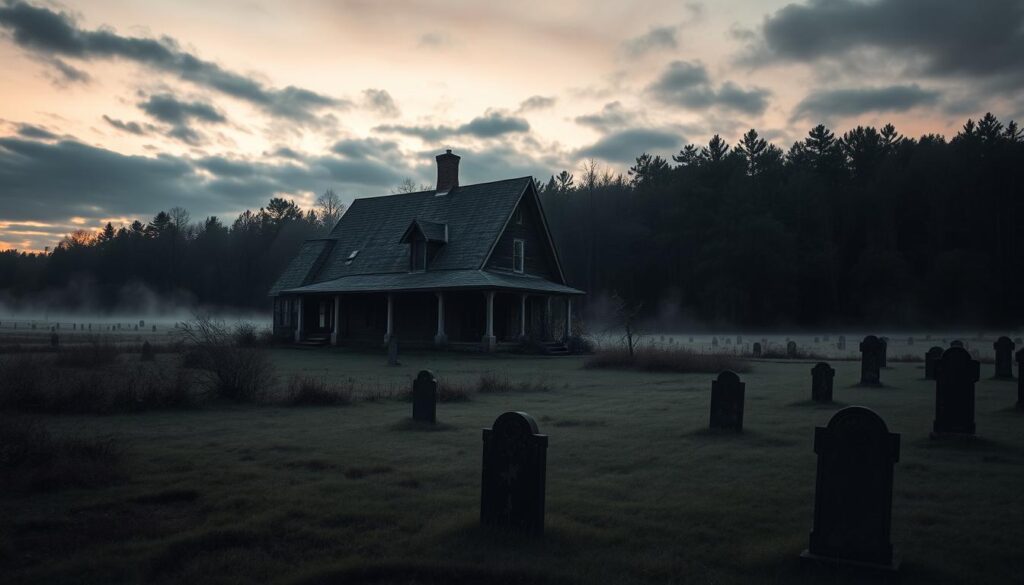
Understanding Spirituality and Southern Myths
The intricate connection between spirituality and Southern myths reveals much about the region’s rich traditions and cultural identity. Southern myths often serve as spiritual cautionary tales, integrating moral lessons that resonate deeply within communities. The essence of these ghost stories underscores the intertwining of folklore and spirituality, resonating with past traumas and communal values.
Works of Southern gothic literature frequently explore themes of haunting, portraying ghosts that evoke discomfort and manifest trauma. Writers like William Faulkner and Flannery O’Connor delve into these unsettling narratives. Their stories reflect the melancholia stemming from the Civil War, highlighting how this pivotal event altered both the landscape and the southern sense of self.
Ancestor veneration occupies a central role in Southern spirituality. Practices such as Hoodoo and holler magic focus on aspects of healing, justice, and the natural world. These traditions arise from a blend of religious beliefs, incorporating elements from African diaspora practices, Indigenous traditions, and European folk magic. They represent a unique spiritual tapestry that continues to influence Southern culture.
The Southern perception of time enhances the understanding of spirituality. The concept of Sankofa illustrates that past, present, and future coexist seamlessly, offering a profound relationship with both ancestors and spirits. This perspective encourages acknowledging historical traumas while seeking healing and justice in the contemporary world.
Understanding the Gothic South illuminates the ongoing haunting present in the region, emphasizing the importance of recognizing and reconciling past experiences. Engaging with Southern myths and folklore serves not only to entertain but also to guide individuals in their journey of identity and community.

The Impact of Urban Legends on American Culture
Urban legends play a significant role in shaping American culture, often reflecting societal fears, beliefs, and values. They emerge from real events, transforming into tales that capture imagination and intrigue. These stories often travel through word of mouth and, in modern times, social media platforms, allowing them to spread rapidly and reach wider audiences.
Many urban legends thrive in specific settings. For instance, residence halls frequently become hotbeds for ghostly rumors, creating bonds among residents through shared spooky experiences. Libraries and theaters, with their quiet atmospheres during late-night hours, frequently feature in tales of haunting. Older buildings, rich in history, are particularly susceptible to accumulations of folklore, which flourish in their shadowy corners.

Even mundane places like bathrooms can transform into eerie locations within legends, illustrating how the ordinary can become extraordinary. Tunnels on college campuses often harbor darker stories involving accidents or tragedy, adding an air of intrigue to their existence. The evolution of urban legends reflects a tradition rooted in storytelling that transmits cultural mores.
As urban legends gained traction in the 1980s, notably through the work of folklorist Jan Harold Brunvand, they began to illustrate modern anxieties. One chilling example emerged in 2014 when the Slender Man legend motivated two girls to commit a horrendous act against their friend. This tale illustrates how impactful these narratives can be, sometimes leading to dangerous behaviors.
Folklorists argue that urban legends provide insights into contemporary societal tensions. They not only entertain but also serve as tools for understanding community dynamics, local history, and even national events. Such legends, whether grounded in truth or pure fiction, have the ability to educate and engage audiences across generations.
| Category | Example | Impact on Culture |
|---|---|---|
| Residence Halls | Ghost Stories | Foster community bonds |
| Libraries/Theaters | Haunting Tales | Intrigue and curiosity |
| Older Buildings | Historical Ghosts | Preserve local history |
| Basements | Isolation Scares | Heightened fears |
| Tunnels | Murder and Death Legends | Unearth intrigue and fears |
Urban legends illustrate the intricate relationship between folklore and American culture, highlighting the significance of storytelling in our communities. As you engage with these tales, keep in mind the underlying messages and lessons they impart, embracing both their entertainment value and their capacity to provoke thought.
Spooky Lore from the Ghost Towns of the West
Ghost towns in the West are not just remnants of past lives; they often come alive with spooky lore and historic tales that capture the imagination. Each town has its own shadowy history, filled with haunting stories that speak to the experiences of those who once called these places home. Exploring these eerie locations reveals a fascinating blend of history and myth.
Historic Locations with Eerie Tales
Many historic ghost towns tell stories of prosperity turned to desolation and the spirits that linger in their wake. For instance, Bodie, California, reached its peak with thousands of inhabitants during the gold rush. Tales of the town’s vibrant past coexist with eerie accounts of sights and sounds that remind visitors of what once was. Bodie’s abandoned buildings and the remnants of its mining operations draw in those curious about its ghostly residents.
Another intriguing spot is the Tillamook Rock Lighthouse, operational until 1957. This location holds the story of the British ship Lupata, which wrecked nearby in 1881. All but one dog perished in the disaster, leading to reports of ghostly ship sightings. Visitors often mention seeing apparitions reminiscent of the ship’s crew, adding to the site’s chilling charm.
The Role of Ghost Stories in Tourism
Ghost stories serve a crucial role in boosting tourism to these haunted locales. People seeking thrilling experiences are often drawn to the idea of encountering spirits from the past. Locations like Bodie offer guided tours and organized history talks, immersing tourists in the haunting narratives that shroud these sites.
- Ghost towns attract thousands of visitors annually.
- Tours often include storytelling that highlights spooky lore.
- Local economies benefit from the influx of tourists looking for historic tales.
- Many towns host seasonal events centered on ghost stories and folklore.
As you explore these ghost towns, remember that every shadow and whisper of the wind may carry a piece of history waiting to be uncovered.

Haunted Locations Worth a Visit
Across the United States, numerous must-visit haunted locations offer a unique blend of historical significance and eerie charm. These sites not only captivate visitors with their storied past but also invite enthusiasts to experience thrilling ghost hunting adventures. Many of these locations boast guided tours, allowing explorers to immerse themselves in chilling tales of the supernatural while uncovering intriguing historical details.
Santa Monica shines as one of California’s most incredible haunted spots, with over 145 years of rich history contributing to its haunted folklore. The famed pier, carousel, and numerous dive bars often serve as hangouts for otherworldly visitors. Notable ghost sightings here include renowned figures such as President Kennedy, Joe DiMaggio, and Marilyn Monroe. The Santa Monica Ghost Adventure tour provides an unforgettable experience for those drawn to the excitement of ghost hunting.
In Pasadena, the Colorado Street Bridge has gained a reputation for being haunted since its first recorded suicide in 1919. Meanwhile, the Hollywood Roosevelt Hotel, home to sightings of Marilyn Monroe, combines glamour with a touch of the supernatural. The Comedy Store on Sunset Strip, where voices and cries echo from a storied past, adds to the city’s haunted allure.
Not far from these locations, Griffith Park is linked to ghostly tales, including that of Doña Petrenilla, whose spirit is said to wander the trails. The iconic Pantages Theatre, formerly owned by Howard Hughes, whispers stories of his ghost inspecting restorations while a melodious female presence fills the air.
Venturing into Ohio, the Ohio State Reformatory offers an unparalleled ghost hunting experience, as visitors often feel invisible hands pushing against them or hear cell doors slam shut on their own accord. Completing this haunted journey, the notorious LaLaurie Mansion in New Orleans entices those intrigued by its dark history, presenting opportunities for a spine-chilling exploration.
| Location | Highlights | Significant Haunting |
|---|---|---|
| Santa Monica, CA | Pier, carousel, historic dive bars | Ghosts of Kennedy and Monroe |
| Colorada Street Bridge, Pasadena, CA | Historic bridge | Reported suicides and hauntings |
| Hollywood Roosevelt Hotel, CA | Luxurious hotel | Ghosts of Monroe and Clift |
| Ohio State Reformatory, Mansfield, OH | Historic prison | Invisible hands & slamming doors |
| LaLaurie Mansion, New Orleans, LA | Historic French Quarter site | Madame Delphine’s troubled spirit |

The Fascination with Haunted Folklore in Media
The portrayal of haunted folklore in media captivates audiences, weaving a web of intrigue around ghost narratives that span generations. In various forms, including films, books, and television shows, these stories shape public perceptions, blending reality with fictional elements. You may find yourself dwelling on iconic films like Poltergeist or The Sixth Sense, which have both influenced and reflected societal attitudes toward the supernatural.
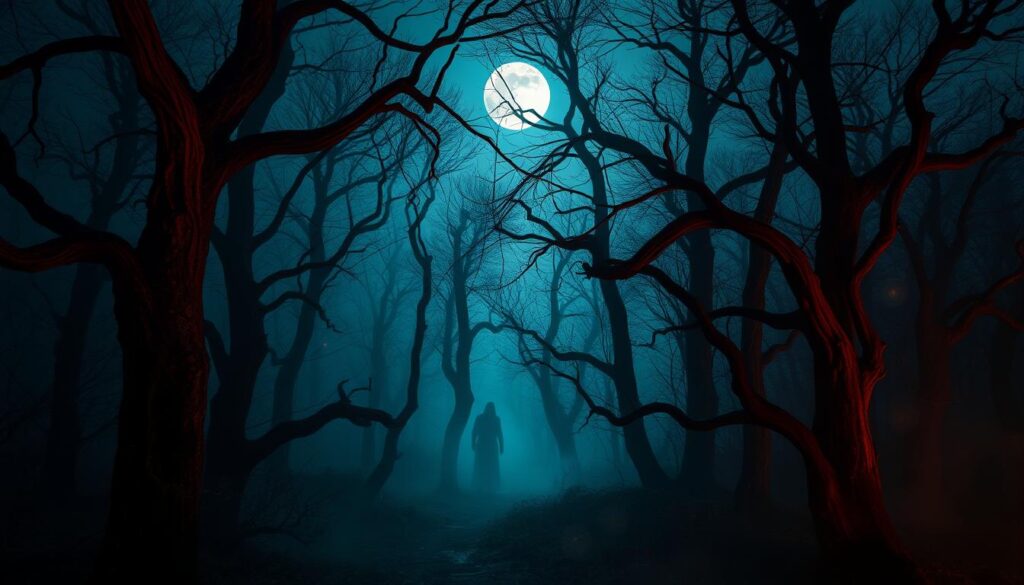
Interestingly, children tend to believe literal ghost stories more readily than adults, who often fabricate their own urban legends, such as the infamous razor blades in Halloween candy. This trend showcases how real-life fears transform into ghost narratives that permeate our culture, fueled by modern anxieties around technology, as seen with the “Blue Whale” game and the “Momo” challenge targeting vulnerable youth.
While adults might share tales of moral panics concerning technology use, kids remain enchanted by the supernatural, particularly during Halloween. This cultural phenomenon marks the onset of a season honoring the dead, deeply rooted in tradition since the 16th century, paving the way for contemporary ghost storytelling.
Media representations play a crucial role in perpetuating the fascination with haunted folklore. Programs like Ghost Hunters and Supernatural delve into eerie narratives, allowing viewers to explore the unknown. Classic ghost stories, such as Charles Dickens’ A Christmas Carol and Shirley Jackson’s The Haunting of Hill House, serve to remind us of the diverse purposes these narratives fulfill, from imparting moral lessons to offering explanations for death.
| Media Type | Influential Titles | Impact on Culture |
|---|---|---|
| Films | Poltergeist, The Sixth Sense, Paranormal Activity | Shape perspectives on death and the afterlife |
| Television | Ghost Hunters, Ghost Adventures, Supernatural | Foster belief in hauntings while entertaining |
| Literature | A Christmas Carol, The Haunting of Hill House | Encourage moral reflection and debate |
As research continues at institutions like the University of Indianapolis, the connection between haunted folklore and media remains pivotal. The exploration of sites like the former House of Blue Lights at Skiles Test Park highlights the interdisciplinary collaboration that enriches our understanding of ghost narratives. This melding of archaeology and experience design ultimately engages a populace eager for connection to their past, fostering interest in haunted locations.
Conclusion
The rich tapestry of haunted folklore across the United States reveals an enduring fascination with ghost legends and supernatural narratives. As we’ve explored, each region offers its own unique stories, from the mysterious tales of the Appalachian Mountains to the spine-chilling accounts of the Southwest. This summary of haunted folklore underscores how these narratives help individuals and communities connect with their past, preserving traditions through oral storytelling.
By engaging with diverse ghost tales, you not only appreciate the chilling experiences but also recognize the cultural significance behind them. For instance, Leah’s classification system for ghost stories highlights sensory manifestations and emotional content that resonate deeply with shared human experiences. The poltergeist stories, which involve moving objects, evoke personal connections reminiscent of caring for loved ones with Alzheimer’s, reflecting how these ghost legends intertwine with our lives.
Ultimately, the evolution of ghost stories showcases their reflection of societal concerns and the ongoing dialogue between the living and the spirits of the past. In understanding these narratives, you gain insight into the relationships people cultivate with non-embodied spirits, emphasizing that not all ghosts are feared but are often embraced as part of a rich cultural heritage. The journey through these haunting experiences invites you to explore further and perhaps even share your own ghostly encounters, keeping the age-old tradition of storytelling alive.

